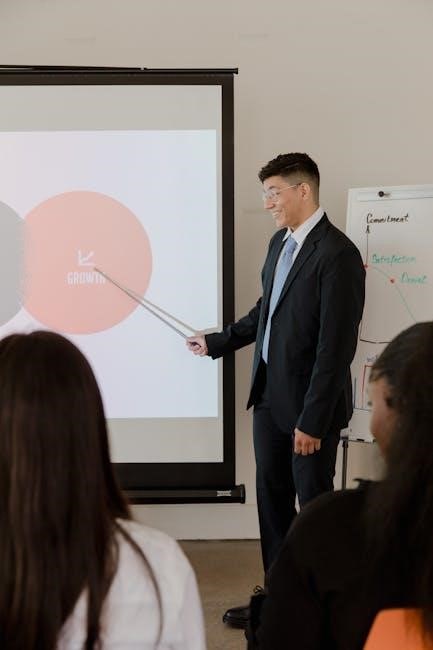Teaching Strategies GOLD Objectives provide a research-based framework for early childhood education‚ focusing on developmental milestones and predictors of school success.
Overview of the Teaching Strategies GOLD Assessment System
The Teaching Strategies GOLD Assessment System is a research-based framework designed to assess developmental milestones in early childhood education. It focuses on 38 objectives across social-emotional‚ cognitive‚ physical‚ and language development. The system provides tools for teachers to track children’s progress‚ aligning with school readiness standards and frameworks like the Head Start Early Learning Outcomes. GOLD objectives are predictors of school success‚ emphasizing the connection between early experiences and future academic achievement. This comprehensive system supports educators in creating tailored learning environments that foster holistic development.
Key Objectives of Teaching Strategies GOLD
Establishing and sustaining positive relationships to support social-emotional growth.
Remembering and connecting experiences to enhance cognitive development.
Using symbols and tools for effective communication and literacy skills.
Establishing and Sustaining Positive Relationships
Building strong‚ positive relationships is foundational for children’s emotional and social development. This objective focuses on fostering trust‚ empathy‚ and collaboration between children‚ teachers‚ and families. Strategies include creating a supportive classroom environment‚ encouraging open communication‚ and promoting teamwork. Activities like group projects and shared goal-setting help children develop interpersonal skills. By nurturing these relationships‚ educators create a safe space for children to express emotions‚ resolve conflicts‚ and feel valued. This foundation is critical for long-term social-emotional growth and academic success. Teachers are encouraged to model positive interactions and provide consistent‚ caring support.
Remembering and Connecting Experiences
This objective focuses on children’s ability to recall and connect past events to present experiences. It emphasizes developing memory skills‚ sequencing abilities‚ and understanding cause-and-effect relationships. Activities such as storytelling‚ discussions about routines‚ and reflective conversations help children build these connections. Teachers encourage children to share personal experiences and link them to classroom learning. This skill fosters critical thinking‚ problem-solving‚ and a deeper understanding of their world. By helping children make meaningful connections‚ educators support their cognitive and social-emotional growth‚ laying a strong foundation for future academic success.
Using Symbols and Tools for Communication
This objective focuses on children’s ability to use symbols and tools to communicate effectively. It includes milestones like using gestures‚ developing vocabulary‚ and understanding symbols. Activities such as reading‚ writing‚ and pretend play help children explore communication tools. Teachers encourage the use of language to express thoughts and needs. This skill is foundational for literacy and social interactions. By mastering symbols and tools‚ children gain confidence in conveying their ideas‚ fostering both cognitive and language development. This objective aligns with school readiness standards‚ preparing children for future academic and social success.

Developmental Domains Covered in GOLD Objectives
Teaching Strategies GOLD Objectives cover Social-Emotional‚ Cognitive‚ Physical‚ and Language & Literacy Development. These domains are interconnected‚ ensuring comprehensive support for children’s growth and learning.
Social-Emotional Development
Social-Emotional Development focuses on skills like self-awareness‚ cooperation‚ and emotional regulation. Teaching Strategies GOLD Objectives help children develop these abilities through positive relationships and experiences. By fostering empathy‚ self-confidence‚ and self-control‚ educators support children in understanding and managing their emotions. This domain encourages collaboration‚ friendship skills‚ and respect for others. Activities promote resilience and problem-solving‚ preparing children for social interactions and academic success. Strengthening these skills early ensures a strong foundation for lifelong well-being and positive relationships.
Cognitive Development
Cognitive Development focuses on enhancing children’s problem-solving skills‚ memory‚ and understanding of the world. Teaching Strategies GOLD Objectives encourage critical thinking through activities like puzzles‚ sorting games‚ and exploring cause-and-effect relationships. These objectives help children develop conceptual knowledge in areas such as mathematics‚ science‚ and technology. By fostering curiosity and exploration‚ educators support children in building foundational skills for academic success. Cognitive development is essential for children to think logically‚ make informed decisions‚ and approach challenges with confidence.
Physical Development
Physical Development in Teaching Strategies GOLD Objectives focuses on fostering children’s motor skills‚ coordination‚ and overall physical well-being. This domain emphasizes both gross motor skills‚ such as running‚ jumping‚ and balancing‚ and fine motor skills‚ like using scissors or puzzles. Activities are designed to promote strength‚ dexterity‚ and body awareness. Additionally‚ the objectives encourage healthy habits and safety practices‚ helping children develop self-care routines. By integrating play and intentional teaching‚ educators support children in mastering physical abilities that are foundational for future learning and overall success.
Language and Literacy Development
Language and Literacy Development in Teaching Strategies GOLD Objectives focuses on building foundational communication and reading skills. This domain includes objectives for verbal and non-verbal communication‚ listening comprehension‚ and early literacy. Activities encourage children to express ideas‚ identify sounds‚ and recognize written symbols. The framework also emphasizes phonological awareness‚ vocabulary expansion‚ and an understanding of print concepts. By fostering a love for reading and writing through playful‚ engaging experiences‚ educators help children develop essential skills that lay the groundwork for future academic success and lifelong learning.

Alignment with Educational Frameworks
Teaching Strategies GOLD Objectives align with the Head Start Early Learning Outcomes Framework and school readiness standards‚ ensuring a cohesive approach to early childhood education and development.
Connection to Head Start Early Learning Outcomes Framework
Teaching Strategies GOLD Objectives closely align with the Head Start Early Learning Outcomes Framework‚ emphasizing social-emotional‚ language‚ and cognitive development. This alignment ensures that GOLD objectives support children’s readiness for school and future success. The framework’s focus on developmental milestones complements GOLD’s research-based approach‚ providing educators with a comprehensive tool to assess and guide learning. By integrating these standards‚ GOLD helps educators track progress and ensure that children meet foundational skills across key domains‚ fostering a strong foundation for lifelong learning and alignment with national educational goals.
Alignment with School Readiness Standards
Teaching Strategies GOLD Objectives are designed to align with school readiness standards‚ ensuring children develop essential skills for transitioning to elementary school. These objectives emphasize social-emotional‚ language‚ and cognitive development‚ which are critical for academic success. By focusing on predictors of school readiness‚ GOLD helps educators assess and support children’s progress toward meeting foundational standards. This alignment ensures that early childhood programs can effectively prepare children for the expectations of formal education‚ fostering a smooth transition and setting the stage for long-term educational achievement.
Implementation Strategies for GOLD Objectives
Classroom activities‚ assessment tools‚ and intentional teaching practices support the implementation of GOLD objectives‚ fostering a structured approach to child development and learning.
Classroom Activities to Support Developmental Goals
Classroom activities are designed to engage children in hands-on learning‚ fostering social-emotional‚ cognitive‚ and physical development. These activities include group projects‚ storytelling‚ and play-based exercises‚ which encourage collaboration and creativity. Teachers use these strategies to align with GOLD objectives‚ ensuring children meet developmental milestones. Assessment tools like checklists and observation notes help track progress‚ allowing educators to tailor activities to individual needs. By integrating intentional teaching practices‚ classrooms create a supportive environment that promotes holistic growth and school readiness. These activities are essential for nurturing a strong foundation for future academic success.

Assessment Tools for Monitoring Progress
The Teaching Strategies GOLD Assessment System provides comprehensive tools to monitor children’s progress toward developmental goals. These tools include observation-based assessments‚ checklists‚ and documentation methods. Teachers use these resources to track milestones in social-emotional‚ cognitive‚ and physical development. The system emphasizes intentional observation‚ allowing educators to gather data on children’s skills and knowledge. This information is then used to inform instruction and support individualized learning plans. Regular progress monitoring ensures that children are on track to meet school readiness standards‚ aligning with the GOLD objectives for development and learning.

Teaching Strategies GOLD objectives are essential for early childhood education‚ aligning with frameworks like Head Start and school readiness standards to foster holistic development and future success.
The Importance of Teaching Strategies GOLD in Early Education
Teaching Strategies GOLD plays a pivotal role in early education by providing a comprehensive assessment system that aligns with developmental milestones. It helps educators identify children’s strengths and areas needing support‚ ensuring tailored instruction. By focusing on predictors of school success‚ GOLD objectives foster social-emotional‚ cognitive‚ physical‚ and language development. This alignment with frameworks like Head Start and school readiness standards ensures that children are well-prepared for future academic challenges‚ making it an indispensable tool for early childhood programs aiming to promote holistic development and lifelong learning.


